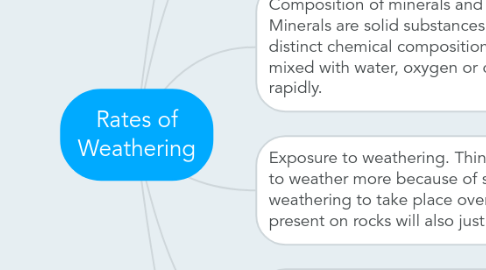Rates of Weathering
by Dante Marx

1. Plants and animals also affect weathering. Biological waste and digging done by animals can affect weathering. Also growth of plant roots under the ground can break rocks. Humans also affect weathering with things like mining and construction
2. Topography is the elevation and shape of the surface of land. Temperatures at high elevations are generally low. For this reason, ice wedging is more common at high elevations than at low elevations. Weathering may happen more quickly on steep slopes, such as mountains. Gravity and heavy rain cause rocks to slide down the mountains. The rocks hit each other and break apart. As rocks fall away, new surfaces are exposed to weathering.
3. Exposure to weathering. Things with greater surface areas tend to weather more because of space present allowing for weathering to take place over a greater area. Thing like joints present on rocks will also just aid for weathering to occur faster.
4. Composition of minerals and does it affect the rate of weathering. Minerals are solid substances found within rocks that have their own distinct chemical composition. Minerals that are most reactive when mixed with water, oxygen or other elements will weather more rapidly.
5. differential weathering is weathering that occurs at different rates, as a result of variations in composition and resistance of a rock or differences in intensity of weathering, and usually resulting in an uneven surface where more resistant material protrudes above softer or less resistant parts.
6. Weathering is the process that breaks down rocks into smaller pieces. The rate at which rock weathers depends on certain factors.


